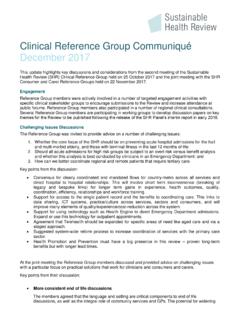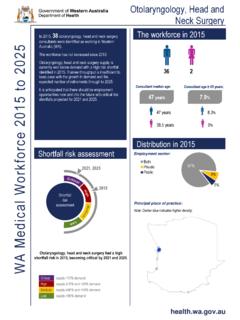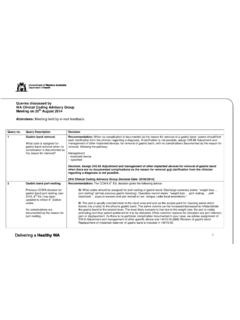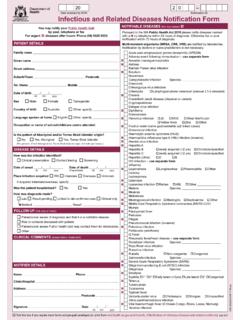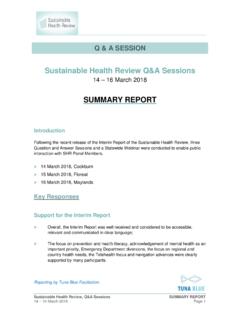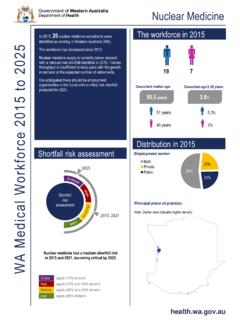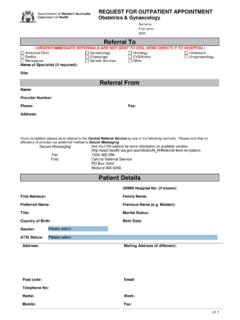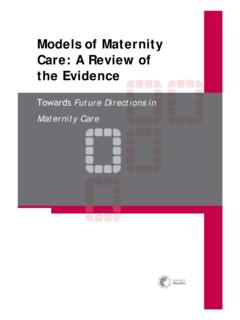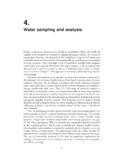Transcription of Standard water sampling technique - ww2.health.wa.gov.au
1 Standard drinking water sampling procedure microbiological To determine the microbiological quality of drinking water it must be sampled and tested in accordance with all of the following: the Australian Drinking water Guidelines1, as published by the National Health and Medical Research Council. AS/NZS :1998 Guidance on the design of sampling programs, sampling techniques and the preservation and handling of samples. AS/NZS :1998 Guidance on sampling of drinking water and water used for food and beverage processing. AS 2031-2012 water Quality sampling for microbiological analysis. the Guidelines for the microbiological Assessment of Drinking Water2. this document. General rules of sampling Take extreme care to avoid contaminating the sample container and the water sample. Use a clean, sterile glass or plastic bottle. If the water is chlorinated, ensure the bottle contains sodium thiosulfate in order to stop the action of the disinfectant.
2 Sodium thiosulfate has no effect on the sample itself and can be used for non-chlorinated waters. Do not use the sample for the measurement of temperature or any other field parameter, as this may contaminate the sample. sampling procedure 1. Clearly label the sample bottle. 2. Turn the tap full on and allow the water to run to waste, 2 to 3 minutes is generally sufficient. This flushes the interior of the nozzle and discharges stagnant water . 3. Disinfect the tap using the Disinfection by flaming' method as outlined below. For household plastic taps, or where flaming is not possible, use the described method for Disinfection where flaming is not possible.'. 1. 2. Produced by Environmental Health Directorate Department of Health 2015. 4. Following disinfection, the tap should be open. Adjust the flow to deliver a gentle stream of water . 5. Hold the bottle in one hand.
3 Remove the screw cap with the other and keep in your hand with the open side down. 6. Fill the bottle almost to the top, leaving a sufficient gap to allow for mixing by the laboratory. Carefully replace the cap. 7. Store and transport in accordance with Sample transportation'. Disinfection by flaming Flaming is the preferred method of disinfection and is suitable for metal taps. After flushing, turn off the tap and sterilise the spout by flaming with a butane or propane burner. Begin at the nozzle and work back towards the body of the tap until the water held in the nozzle boils. Lighters/methylated spirits do not generate sufficient heat and should not be used. Open the tap to half-flow and run to waste until a constant temperature is reached. Disinfection where flaming is not possible For disinfection of household, plastic taps where flaming is not suitable, or where an open flame cannot be used, the following alternatives can be used for disinfection: Sodium hypochlorite solution, freshly made up to 1 g/L free chlorine.
4 Ethanol or isopropanol, 70% volume/volume. After flushing, turn off the tap and dip in a solution of hypochlorite, ethanol or isopropanol for 2. to 3 minutes. Alternatively, a swab, spray or wash bottle may be used to disinfect the outside and as much of the inside as possible, waiting 2 to 3 minutes for the solution to take effect before turning the tap on again. Take caution using sodium hypochlorite, as it is a strong oxidising agent and is highly corrosive. Dip samples 1. Hold the bottle in one hand near the base; remove the screw cap with the other. 2. Collect the sample from approximately 300 mm below the water surface. Take care to avoid any surface film entering the bottle by plunging it, neck downwards as it enters the water . 3. Turn the bottle until the neck points slightly upwards while moving it in the direction of the mouth during filling.
5 Create an artificial current by pushing the bottle horizontally forwards and away from the hand. Care should be taken to ensure that the bottle fills before the Produced by Environmental Health Directorate Department of Health 2015. forward motion is completed. This prevents contamination from the samplers hand from entering the bottle. 4. Fill the bottle almost to the top, leaving an air gap of approximately 5 mm. 5. Carefully replace the cap. 6. Store and transport in accordance with Sample transportation'. Sample transportation Bacteriological Place the sample in an insulated container with sufficient ice bricks or artificial ice packs to maintain a temperature of 2-8 C during transportation. Loose ice should only be used if melted ice can be prevented from entering sample containers with the use of zip-lock, water -tight bags. Samples should be received at the laboratory no more than 24 hours after sampling .
6 Amoeba water samples for amoeba testing should be transported in an insulated container at ambient (not chilled) temperature. Samples should be received in the laboratory no more than 96 hours after sampling . For other microbiological sample types, refer to AS2031-2012 for sample transport times and storage recommendations. Always: Do Not: use a clean, sterile bottle. touch the inside of the bottle label the bottle prior to sampling rinse the bottle adequately flush the line (2 to 3 minutes touch the inside of the bottle or allow is sufficient) contact between the bottle and the tap disinfect the tap using an approved put caps on the ground while sampling method transport drinking water samples with take microbiological samples first other water sample types sewage Produced by Environmental Health Directorate Department of Health 2015. Submitting samples The following information has been provided for samples sent to PathWest for analysis.
7 If the sample is being submitted to a private laboratory, refer to the chosen laboratory for advice on correctly completing the sample bottle details and accompanying analysis request form. Sample labelling It is essential that all samples that are sent to PathWest be given a site code number before they are submitted for testing. For more information regarding site code allocation refer to Site Code Identification System for water Samples', published by the Department of Health. The accompanying sample request forms should be completed in full with the following information: Your reference Site code Sample description water source Date and time of collection Transport temperature sampling agency (or company name). sampling agency (or company name) and address site code sample description sample collection date time of sample collection treatment type chlorine, UV (if applicable).
8 Email address for results Produced by Environmental Health Directorate Department of Health 2015. More information water Unit Environmental Health Directorate Department of Health PO Box 8172. PERTH BUSINESS CENTRE WA 6849. Telephone: (08) 9388 4999. Fax: (08) 9388 4910. This document is available in alternative formats on request for a person with a disability. Produced by Environmental Health Directorate Department of Health 2015. Field reference guide Ensure you have read the Standard drinking water sampling procedure microbiological '. Clearly label a clean, sterile bottle. For chlorinated supplies, ensure the bottle contains sodium thiosulfate. Turn tap full on and run to waste for 2 to 3 minutes. Disinfection by flaming Disinfection for plastic taps (or flaming is not possible). Use a propane or butane burner Use sodium hypochlorite solution (1g/L free chlorine).
9 Or ethanol/isopropanol 70% v/v. Flame the tap thoroughly, starting at the nozzle and working Solution Swabs, wipes or wash bottle backwards until the water held in the nozzle boils. Dip the tap Swab, wipe or wash the inside and for 2-3 mins. outside of the tap. Wait 2-3 minutes. Open the tap and run to waste until Open tap and run to waste, allowing removal of any a constant temperature is achieved. excess solution. Adjust the flow to deliver a gentle stream of water . Holding the bottle in one hand, remove the screw cap with the other. Hold the cap open side down and keep it close to the bottle. Fill the bottle almost to the top, leaving a gap for mixing (approx 5 mm). Carefully replace the cap. Bacteriological Amoeba Place samples in an insulated container with ice bricks (maintain a temperature of 2-8 C). Store at ambient temperature (not chilled).
10 Transport to lab within 24 hours. Transport to laboratory within 96 hours. Complete the laboratory sample request form and dispatch samples for analysis.
